Climate change 2023: The year of extremes
The catastrophic climate record of the summer of 2023.
The warmest months ever, sea temperatures higher than ever, Antarctic sea ice lower than ever – extreme weather events such as heavy rain, heat waves, droughts, storms.
Global response: zero – Emissions continue to rise unabated worldwide.

„Climate change“ was for decades a topic discussed only in expert circles, for about ten years now the climate crisis slowly enters the consciousness of many people, to show today ,in 2023, unexpectedly violent and rapid catastrophic consequences. I have been studying the laws of macroclimate for over 30 years, and in particular man-made global warming. (See the Climate Change (Klimawandel) category of this blog with over 30 posts).
The initially only slightly noticeable consequences of climate change and also the not insignificant group of contemporaries who were critical of the thesis of man-made climate change contributed to the fact that this topic found hardly any public interest. Even the first IPCC reports, whose scenarios showed extremely differentiated, wide-ranging possible developments, could not change this. Only in recent years has it gradually become apparent that the worst-case scenarios, which many initially regarded as quite improbable, would increasingly become reality unless rigorous measures were taken. More and more climate-related damage events were also recorded globally, with heat waves, droughts, storms, and heavy rain hitting the headlines.
On the political level, the world community decided to aim for the 1.5 degree target and to reduce CO2 emissions accordingly. Climate activists such as „Fridays for Future“ and the „Last Generation“ call for decisive action, climate protection, energy transition, transport transition are late answers to the urgent questions of how to avert the impending climate catastrophe.
Then came the summer of 2023 with record climate values that greatly surprised the scientific community, myself included. Never before had such abrupt temperature jumps been measured on a global scale: Temperature records on almost all continents, an incredible warming of the oceans, tremendous amounts of rainfall as in the Mediterranean region, but also in Asia and South America, plus an extreme reduction of Antarctic sea ice. In the following I would like to summarize the current dramatic development of our climate.
NASA confirms: The summer of 2023 was the warmest on record, and 2023 is very likely to be warmer than any year before it.
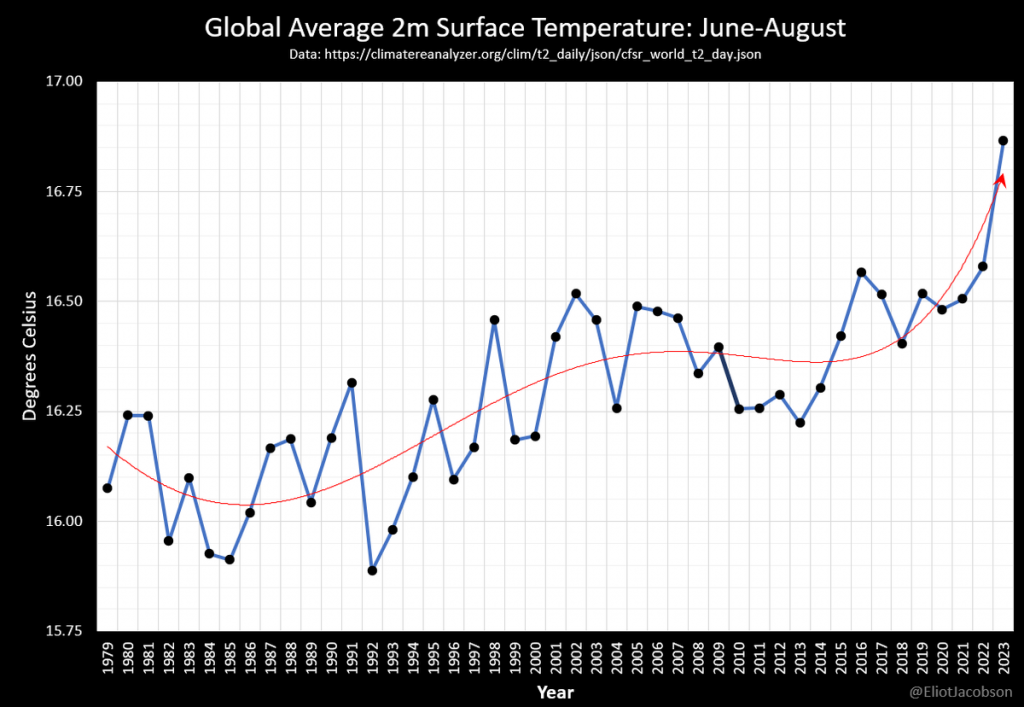
The graph clearly shows how warm these three months of the northern summer of 2023 .were. At the same time, the El Nino event has just begun.
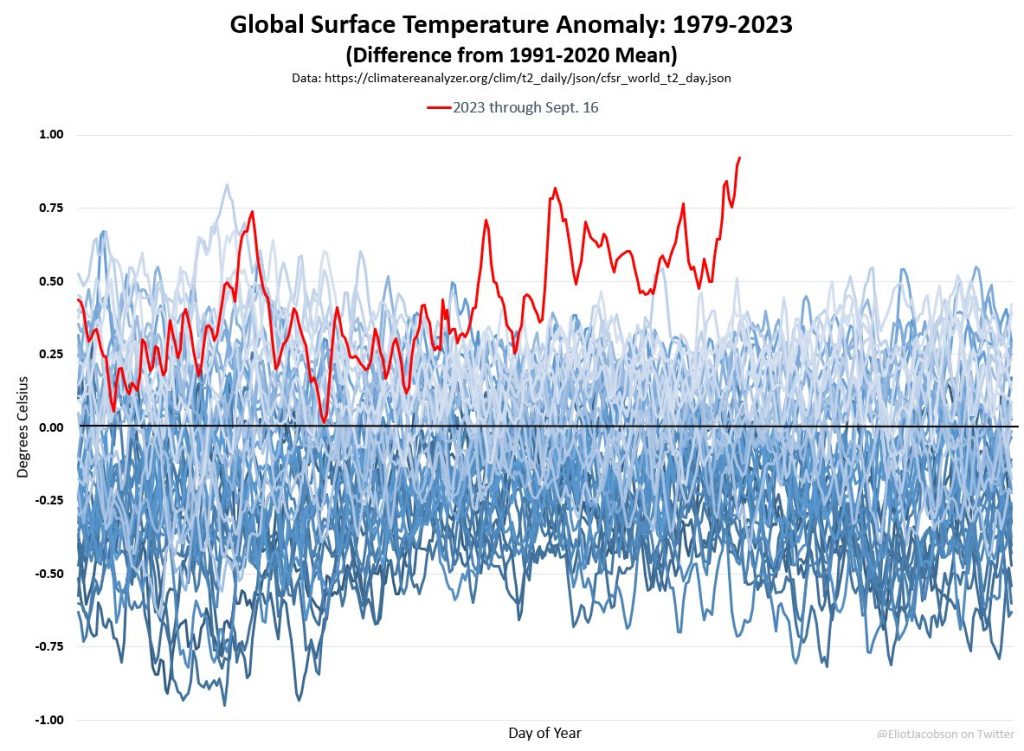
In this graph by Eliot Jacobsen you can clearly see how the daily values of the year 2023, i.e. January to September, exceed almost all previous measured values. The lines in the darker blue correspond to the measured values from the earlier years of the measurement period, the transition to the lighter blue corresponds to the years of the recent past up to the present, at the very top. Thus, from about May to mid-September, the values for all days in 2023 are well above those for all days in the past 40 years.
Year-to-date, the planet’s temperature is now 1.37°C above the 1850-1900 baseline temperature, with about a 50% chance of exceeding the Paris limit of 1.5°C for this year.
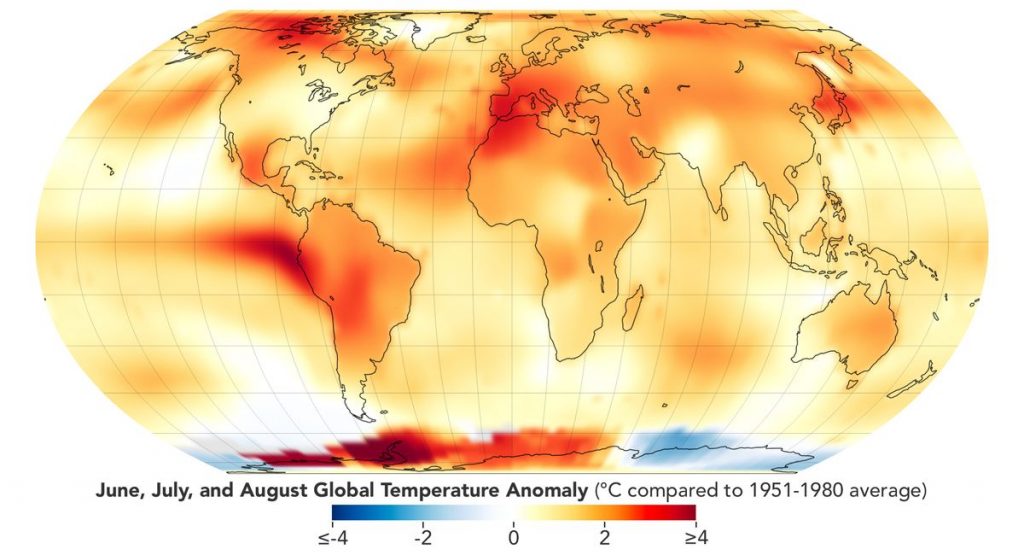
Antarctic sea ice shows unusually low extent in winter there
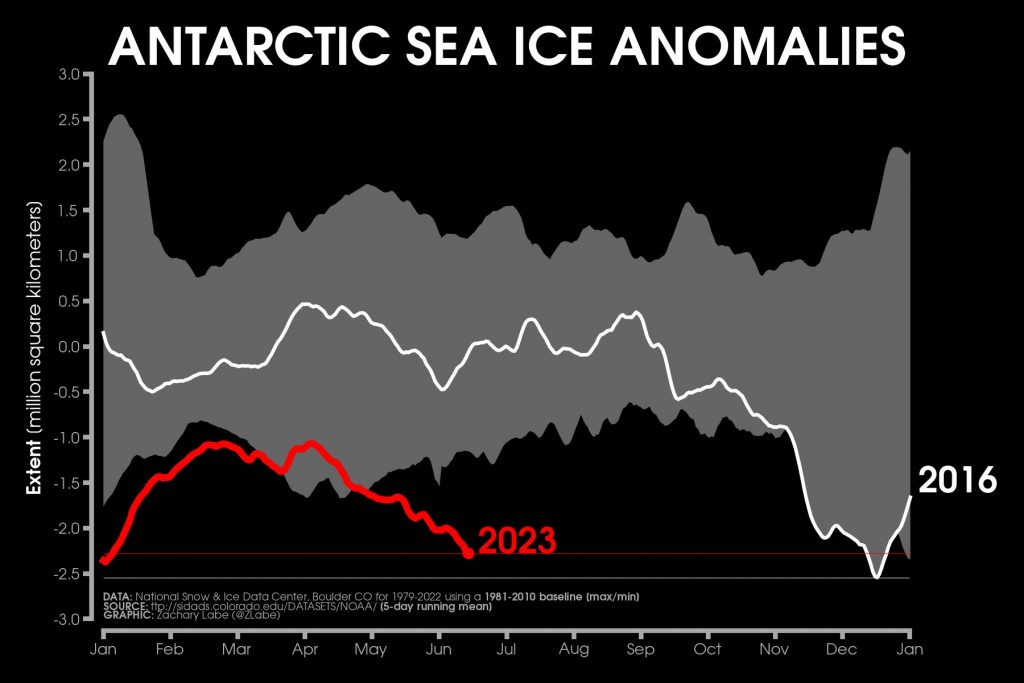
Antarctic sea ice is a crucial component of the global climate system. Climatologically, Antarctic sea ice reaches its annual minimum in mid-February to early March. Sea ice cover in January and February 2023 broke monthly and daily records for sea ice extent during this time of year. On February 10, 2023, sea ice cover exceeded the daily record minimum of 1.91 million square kilometers set a year earlier on February 21, 2022. On February 19, 2023, a new minimum Antarctic sea ice extent of 1.77 million square kilometers was observed,4 1.02 million square kilometers (36%) less than the average daily minimum sea ice extent from 1979 to 2022.
In the monthly measurement series, the sea ice extents in January and February 2023 were the largest negative anomalies recorded in the 44-year observation period.
In particular, the enormous decrease in ice sheet extent from April to July 2023 indicates processes that have been poorly understood to date and should be seen as alarm signals for an unexpectedly rapid melting of the Antarctic ice shelf as well.
September 2023: „Antarctic sea ice may have already reached its maximum extent for the year at 16,980,000 km². Prior to this year, there was no recorded maximum below 18,000,000 km².“ (Eliot Jacobson)
First indications of the expected consequences for the fauna in the Antarctic region:

A catastrophic die-off of emperor penguin chicks has been observed in the Antarctic, with up to 10,000 young birds estimated to have been killed.
The sea-ice underneath the chicks melted and broke apart before they could develop the waterproof feathers needed to swim in the ocean.The birds most likely drowned or froze to death. The event, in late 2022, occurred in the west of the continent in an area fronting on to the Bellingshausen Sea. (BBC News)
Antarctic krill, the most important food source for whales and fish, is also likely to be threatened by rising seawater temperatures.
The oceans – warmer than ever
The simultaneous occurrence of numerous areas of exceptionally/record warm seawater outside the tropics and a strong El Niño event localized in the eastern Pacific has never been observed before. The oceans currently exhibit a configuration that has no modern analogue, and it is expected to remain so, becoming even more pronounced in 2024.

The graph shows the surface temperatures of the oceans, the second dotted line from the bottom represents the mean value of the years 1982 to 2011, the dotted lines above and below show the standard deviation sigma, this is a measure of the dispersion of data. It indicates the average deviation of all collected values from their mean value. The orange line marks the year 2022 and the top black line (to Sep 21) marks the record year 2023 with a deviation from the mean of almost one degree! Note that these are the averages of all the oceans on the planet.
Let us now consider the North Atlantic.
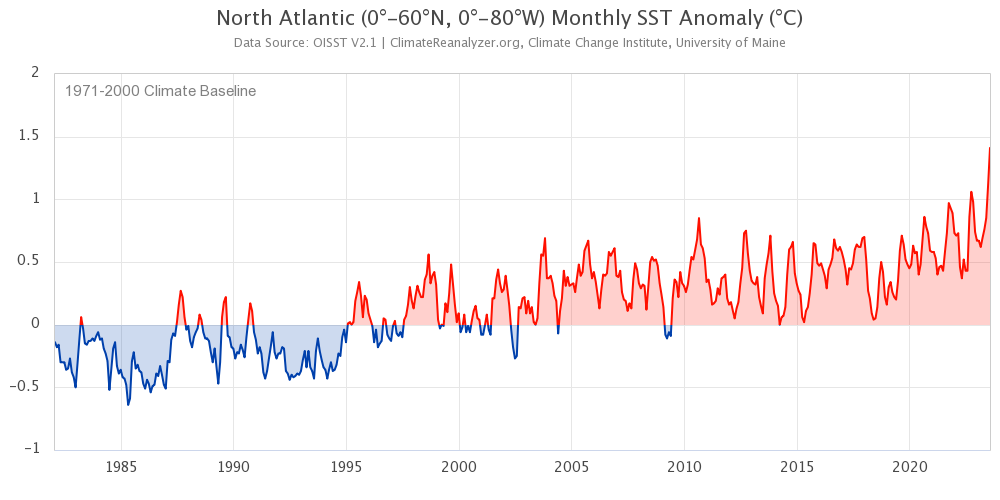
Here we see the deviations from temperature averages of the years 1971 – 2000. The positive deviations from about 2004 moved around 0.5 degrees, then increased from 2020 to reach a record value in 2023.
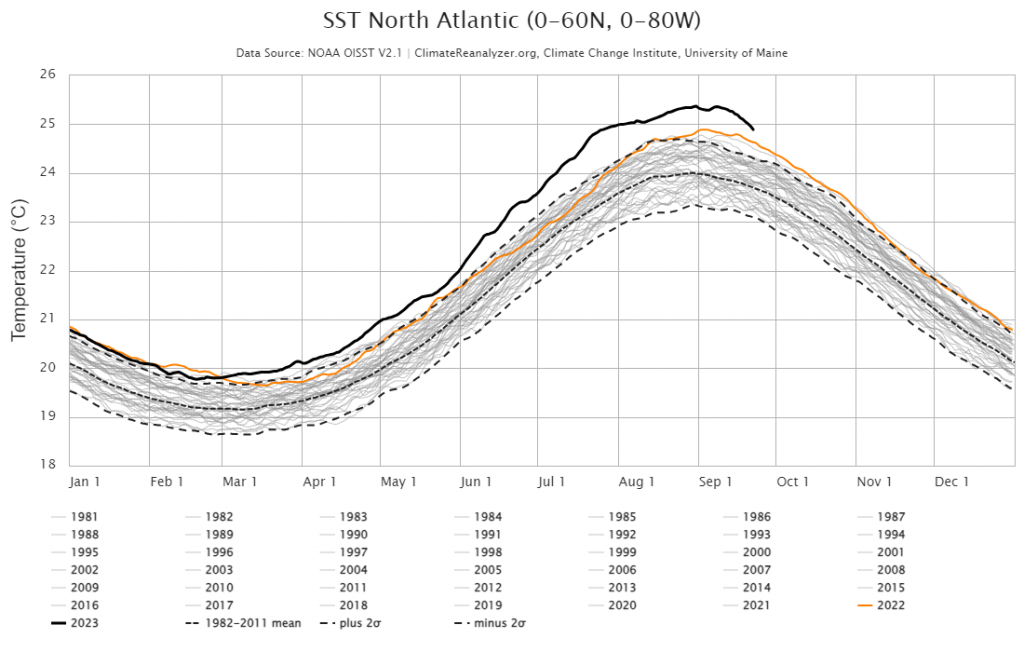
Here are the averaged daily values of the last 40 years, i.e. the sea water surface temperatures of the North Atlantic. The maximum values are found at the beginning of September. The mean value here is 24.0°C, the lowest daily value we find in 1992 with 23.3°C. The highest values as expected from 2020, The first days of September 2022 showed amazing maxima of 24.9°C. The absolute maximum, however, was measured on September 8, 2023: 25.4°C! A huge jump of 0.5 K in only one year, for the same temperature increase it took the past 10 years! This exceeds all previous forecasts and so far there is no convincing explanation for it.
Possible causes: The so-called indirect aerosol effect of ship emissions on the climate, especially through sulfur emissions. These have decreased by approx. 80% due to stricter regulations and the previous cooling effect has thus ceased. A beginning strong El Nino event as well as the reaching of so far not recognized tipping elements.
Extreme weather events so far in 2023:
Heat waves
New temperature records were set in the United States, China, Europe, North Africa and the Middle East, with deadly consequences for some who could not escape the heat. June through August were the hottest three months globally since records began,
In many parts of the world, the extreme heat was accompanied by high humidity, which can lead to dangerous increases in body temperature and stress on the cardiovascular system. In the United States and the Middle East, the „wet bulb“ temperature, a measure of heat that includes humidity, reached levels that scientists consider potentially deadly.
Forest fires
Under the summer’s extreme conditions, fires raged on an unprecedented scale. According to the European Union’s Copernicus atmospheric monitoring service, Canada doubled its previous record for carbon emissions from wildfires in the worst season ever. In Europe, Greece recorded its strongest wildfire outbreak ever. And in the Pacific, a fire on Maui, Hawaii, became the deadliest wildfire in the U.S. in more than a century.
The extraordinary warming of the oceans
Key ecosystems are at risk; coral bleaching off the Florida coast began months earlier than usual, sparking fears of an ecologically destabilizing mass die-off. Stronger storms and accelerated sea level rise continue to threaten coastal communities and the global economy. Without adaptations to climate change, flood damage caused by rising sea levels could cost the world as much as $50 trillion annually, or about 4 percent of global gross domestic product (GDP), according to the Organization for Economic Cooperation and Development (OECD).
Like the rise in air temperatures, ocean warming is primarily caused by human activities; the oceans absorb up to 90 percent of the heat generated by greenhouse gas emissions. According to a 2018 study by the IPCC, half of the rise in sea level over the past fifty years is due to higher ocean temperatures. The United Nations calls sea level rise a „threat multiplier“ that can lead to more dangerous hurricanes, typhoons, and flooding.
Warm oceans also enrich the atmosphere with moisture and increase latent energy content, which in turn leads to stronger storms and extreme heavy rainfall.
Floods and droughts
High temperatures have led to record rainfall around the world. The deadliest hurricane ever in the Mediterranean region dumped record amounts of rain in Libya, overtopping dams and causing catastrophic flooding; more than 10,000 people have died and thousands are still missing. In India, monsoon rains killed more than a hundred people. And in the United States, heavy rains in Vermont caused the worst flooding in a century, while parts of Kentucky recorded the highest rainfall totals ever in a twenty-four hour period, according to NOAA. Overall, the summer’s floods caused billions of dollars in damage.
Meanwhile, countries like Chile and those in the Horn of Africa are facing the worst droughts in decades. (Extreme heat can worsen droughts by accelerating evaporation, which reduces surface water and dries out soils.) Like higher sea levels, droughts can exacerbate other severe weather disasters. Drier soils are less absorbent, making floods more frequent and destructive. According to a study by the American Geophysical Union, this can also increase the risk of wildfires by up to 80 percent.
Global Response? The response of the global community.
Almost all countries have signed the 2015 Paris Agreement, which aims to limit the global temperature increase to „well below“ 2 °C above pre-industrial levels. The scientific community agrees that to avoid the worst effects of climate change, it is necessary to limit this increase to no more than 1.5 °C. However, as CO2 and also methane emissions continue to rise globally, the world is expected to exceed this limit in the coming years. July 2023 was the first full month to exceed the 1.5°C limit, while most of the world’s population experienced a series of extremes that summer – a foretaste of an overheated world. „Never before has the destructive power of climate change been so evident around the world,“ writes Alice Hill, CFR Senior Fellow for the US Council of Energy and the Environment.
This graphic shows how little is being done on a global scale to counteract the impending catastrophe:

CO2 / methane / nitrogen oxide emissions continue to rise steeply.
Another important atmospheric heat balance parameter is the Earth Energy Imbalance, (EEI), the difference between the amount of energy arriving on Earth and the amount returning to space. It serves as the basic metric by which the Global Climate Observing System, (GCOS), co-funded by WMO, can assess how well the world is responding to the task of bringing climate change under control.
A study published in Earth System Science Data (ESSD), a major open-access journal from Copernicus Publications, has shown that the Earth’s energy imbalance continues to grow, increasing by nearly 50% over the past 14 years compared to the amount accumulated over the past half decade.
Researchers involved in the study drew on carefully calibrated, cross-referenced and well-documented data from the ocean, land, ice and atmosphere to reach important conclusions:
In the years since 1971 until about 2006, the Earth has warmed by about 0.5 watts per square meter of its surface. More recently, however (2006 to 2020), warming has increased to over 1.0 watts per square meter, rising to 1.4 W/m² in 2023. Most of the heat is absorbed by the oceans (89%), with the remaining global heat going to the land (6%), ice (4%), and atmosphere (1%).
Conclusion
The alarm signals can no longer be ignored. Our climate is moving faster than expected towards a point of no return. Business as usual in this situation would be a fatal mistake. Politicians who do not take decisive action now, including unpopular measures, are either irresponsible or stupid. But every responsible citizen of the global community should also actively support climate protection within the scope of his or her possibilities. Ignoring these facts or even denying it is not an option.
The era of global warming has ended; the era of global boiling has arrived. Leaders must lead. No more hesitancy. No more excuses. No more waiting for others to move first. There is simply no more time for that. It is still possible to limit global temperature rise to 1.5 degrees Celsius and avoid the very worst of climate change. But only with dramatic, immediate climate action.
UN Secretary General António Guterres
At the presentation of the IPCC Report 2023 and the new Copernicus data
Here is another excellent summary of the state of our climate 2023:
William J Ripple, Christopher Wolf, Jillian W Gregg, Johan Rockström, Thomas M Newsome, Beverly E Law, Luiz Marques, Timothy M Lenton, Chi Xu, Saleemul Huq, Leon Simons, Sir David Anthony King, The 2023 state of the climate report: Entering uncharted territory, BioScience, 2023;, biad080, https://doi.org/10.1093/biosci/biad080
Bernd Riebe, SEP 2023
Update NOV 19, 2023
Well humanity, we did it, even if just for one day. Yesterday, Nov. 18, was the first time in recorded history that the global 2m surface temperature breached 2.0°C above the 1850-1900 IPCC baseline. (Eliot Jacobson)
Weitere Beiträge zum Thema in der Karegorie Klimawandel und auf meinem YouTube Channel

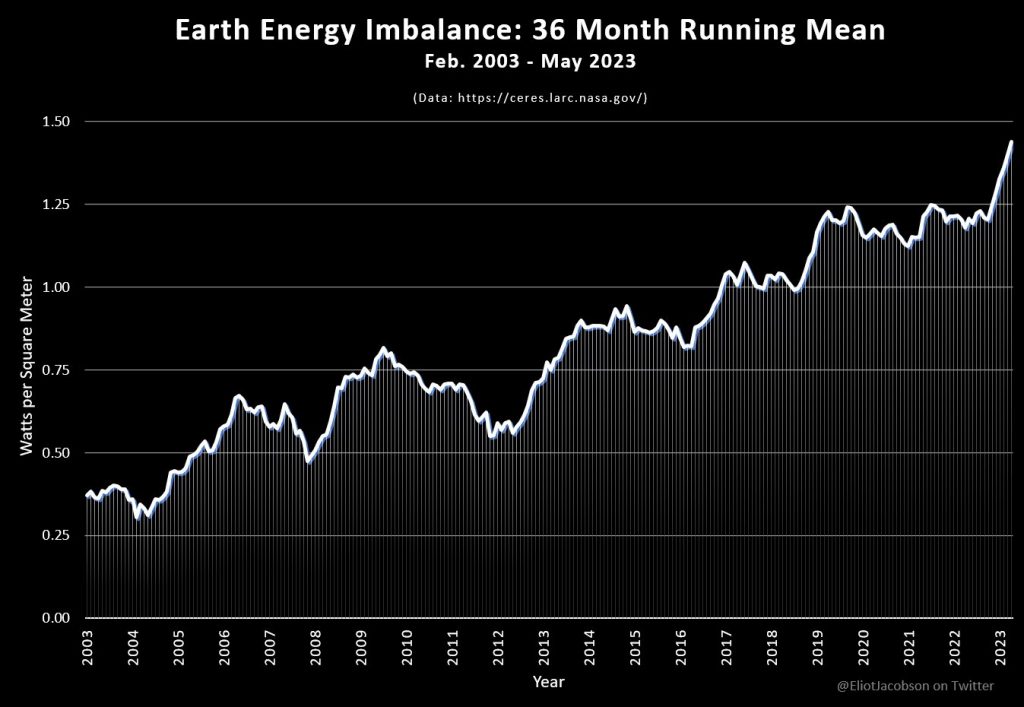

Schreibe einen Kommentar